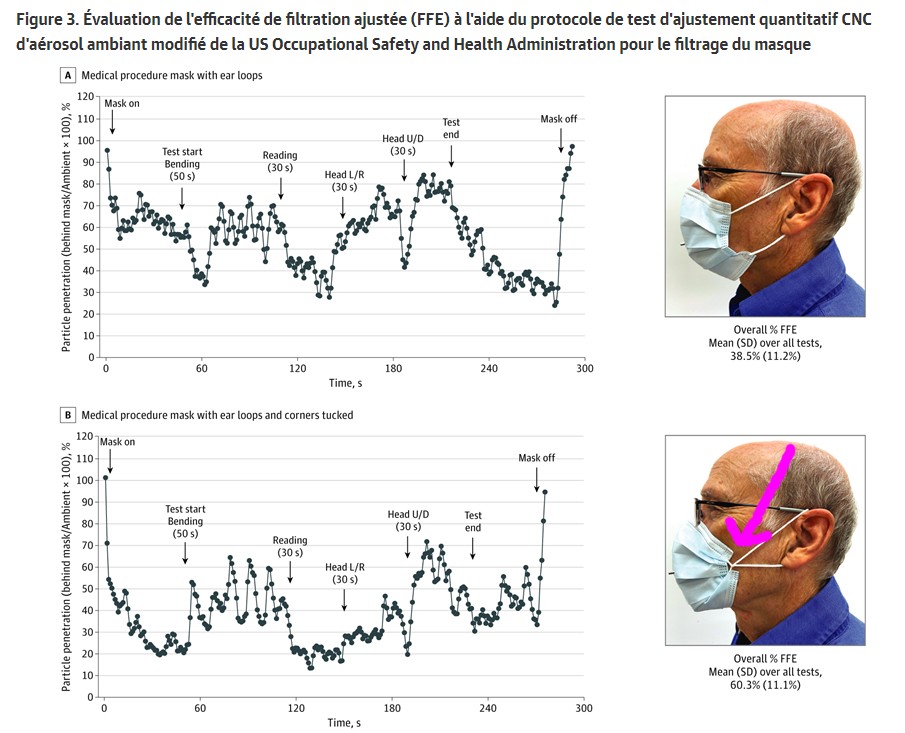 par Nutrimuscle-Conseils » 11 Déc 2020 00:00
par Nutrimuscle-Conseils » 11 Déc 2020 00:00
Evaluation of Cloth Masks and Modified Procedure Masks as Personal Protective Equipment for the Public During the COVID-19 Pandemic
Phillip W. Clapp, JAMA Intern Med. Published online December 10, 2020.
Question What are the fitted filtration efficiencies (FFEs) of consumer-grade masks, improvised face coverings, and modified procedure masks commonly used during the coronavirus disease 2019 (COVID-19) pandemic?
Findings In this comparative study of face covering FFEs, we observed that consumer-grade masks and improvised face coverings varied widely, ranging from 26.5% to 79.0% FFE. Modifications intended to enhance the fit of medical procedure masks improved FFE measurements from 38.5% (unmodified mask) to as much as 80.2%.
Meaning Simple modifications can improve the fit and filtration efficiency of medical procedure masks; however, the practical effectiveness of consumer-grade masks available to the public is, in many cases, comparable with or better than their non-N95 respirator medical mask counterparts.
Abstract
Importance During the coronavirus disease 2019 (COVID-19) pandemic, the general public has been advised to wear masks or improvised face coverings to limit transmission of severe acute respiratory syndrome coronavirus 2 (SARS-CoV-2). However, there has been considerable confusion and disagreement regarding the degree to which masks protect the wearer from airborne particles.
Objectives To evaluate the fitted filtration efficiency (FFE) of various consumer-grade and improvised face masks, as well as several popular modifications of medical procedure masks that are intended to improve mask fit or comfort.
Design, Setting, and Participants For this study conducted in a research laboratory between June and August 2020, 7 consumer-grade masks and 5 medical procedure mask modifications were fitted on an adult male volunteer, and FFE measurements were collected during a series of repeated movements of the torso, head, and facial muscles as outlined by the US Occupational Safety and Health Administration Quantitative Fit Testing Protocol. The consumer-grade masks tested included (1) a 2-layer woven nylon mask with ear loops that was tested with an optional aluminum nose bridge and nonwoven filter insert in place, (2) a cotton bandana folded diagonally once (ie, “bandit” style) or in a (3) multilayer rectangle according to the instructions presented by the US Surgeon General, (4) a single-layer woven polyester/nylon mask with ties, (5) a nonwoven polypropylene mask with fixed ear loops, (6) a single-layer woven polyester gaiter/neck cover balaclava bandana, and (7) a 3-layer woven cotton mask with ear loops. Medical procedure mask modifications included (1) tying the mask’s ear loops and tucking in the side pleats, (2) fastening ear loops behind the head with 3-dimensional–printed ear guards, (3) fastening ear loops behind the head with a claw-type hair clip, (4) enhancing the mask/face seal with rubber bands over the mask, and (5) enhancing the mask/face seal with a band of nylon hosiery over the fitted mask.
Main Outcomes and Measures The primary study outcome was the measured FFE of common consumer-grade and improvised face masks, as well as several popular modifications of medical procedure masks.
Results The mean (SD) FFE of consumer grade masks tested on 1 adult male with no beard ranged from 79.0% (4.3%) to 26.5% (10.5%), with the 2-layer woven nylon mask having the highest FFE. Unmodified medical procedure masks with ear loops had a mean (SD) FFE of 38.5% (11.2%). All modifications evaluated in this study increased procedure mask FFE (range [SD], 60.3% [11.1%] to 80.2% [3.1%]), with a nylon hosiery sleeve placed over the procedure mask producing the greatest improvement.
Conclusions and Relevance While modifications to improve medical procedure mask fit can enhance the filtering capability and reduce inhalation of airborne particles, this study demonstrates that the FFEs of consumer-grade masks available to the public are, in many cases, nearly equivalent to or better than their non-N95 respirator medical mask counterparts.



 Forum Nutrimuscle, Nutrition, musculation, transparence !
Forum Nutrimuscle, Nutrition, musculation, transparence !  Actualités, vidéos, études scientifiques
Actualités, vidéos, études scientifiques
![]() par Nutrimuscle-Conseils » 10 Déc 2020 22:24
par Nutrimuscle-Conseils » 10 Déc 2020 22:24 
![]() par Nutrimuscle-Conseils » 11 Déc 2020 00:00
par Nutrimuscle-Conseils » 11 Déc 2020 00:00 ![]() par Nutrimuscle-Conseils » 24 Mar 2021 00:19
par Nutrimuscle-Conseils » 24 Mar 2021 00:19 ![]() par Nutrimuscle-Diététique » 25 Mar 2021 15:56
par Nutrimuscle-Diététique » 25 Mar 2021 15:56 










